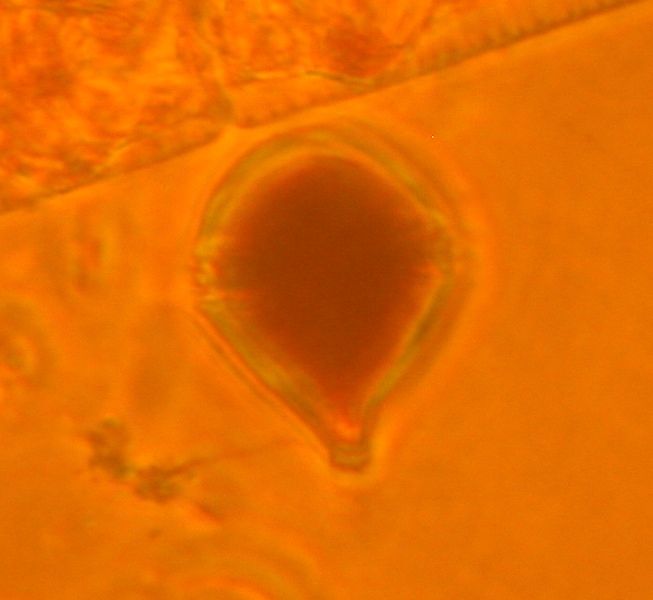Akashiwo sanguinea
Algal Group: Dinoflagellates (Dinophyta)
Description
has many different forms, one rounded end and one end with two lobes; 40-80 µm long; central nucleus; one transverse flagellum and one longitudinal flagellum
Where we found it
Indian River
Sebastian
Frequency of occurrence
Indian River: 23% in 116 samples taken
Suwannee Sound: 0% in 120 samples taken
What Are The Effects On Clams?
Good
Why is it good?
acceptable food item for clams
Ecological considerations:
major bloom-former; blooms can occur any time of year, but most common in warm months; extreme bloom events can be associated with reduced oxygen levels in the water column
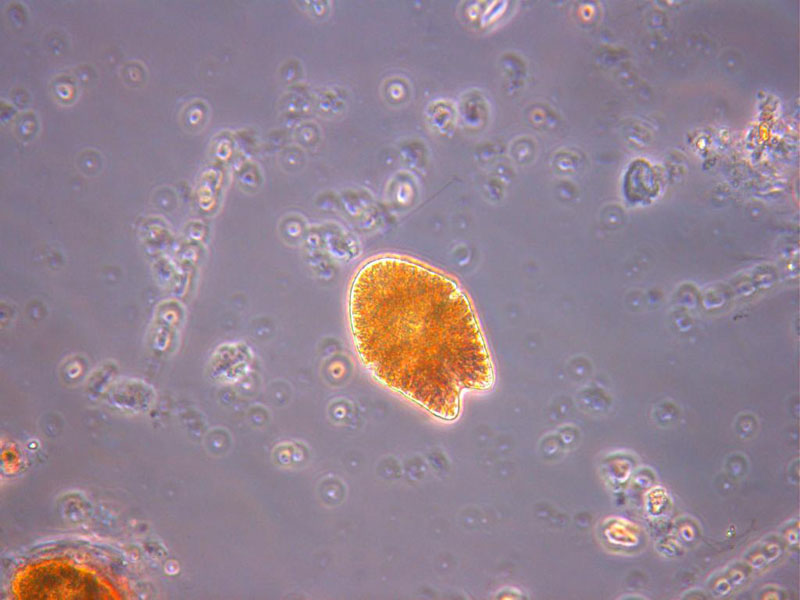
Amphidinium operculatum
Algal Group: Dinoflagellates (Dinophyta)
Description
oblong cells; < 20 µm; one transverse flagellum and one longitudinal flagellum
Where we found it
Indian River
Sebastian
Frequency of occurrence
Indian River: 5% in 116 samples taken
Suwannee Sound: 0% in 120 samples taken
What Are The Effects On Clams?
Good; Bad
Why is it good?
acceptable food item for clams
Why is it bad?
This species has been shown to produce amphidiniols, compounds with hemolytic (lyse red blood cells) properties, but reports from the natural environment are rare.
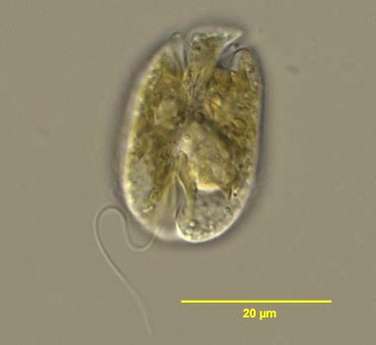
Ceratium hircus
Algal Group: Dinoflagellates (Dinophyta)
Description
pentagonal cells with three long horns, one on top portion and two on bottom; 35-70 µm long, 30-45 µm wide at girdle
Where we found it
Indian River and Suwannee Sound
Sebastian
DE;GJ;PI;HB;PR
Frequency of occurrence
Indian River: 59% in 116 samples taken
Suwannee Sound: 53% in 120 samples taken
What Are The Effects On Clams?
Good
Why is it good?
acceptable food item for clams
Ecological considerations:
Extreme bloom events can be associated with reduced oxygen levels in the water column.
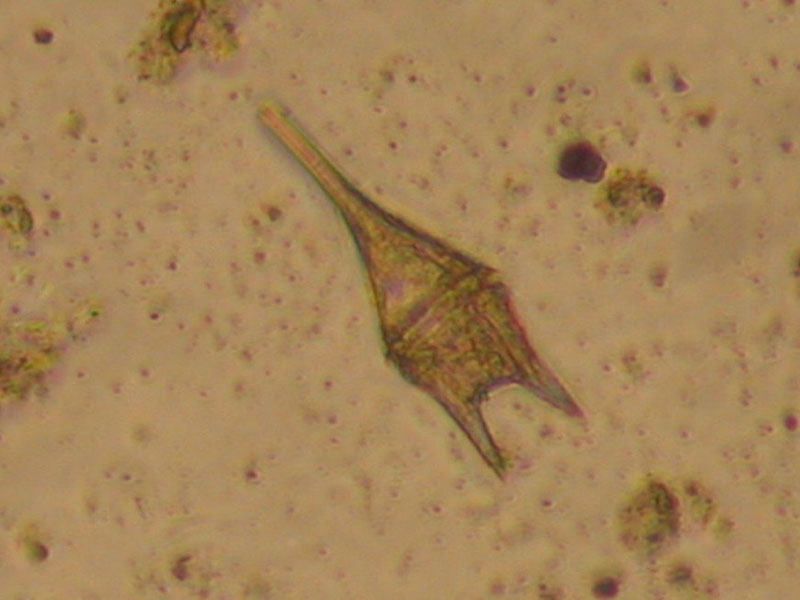
Dinophysis caudata
Algal Group: Dinoflagellates (Dinophyta)
Description
oblong cells; approximately 70 µm long; well-developed wing-like structure (sulcal list) on side
Where we found it
Indian River and Suwannee Sound
Sebastian
DE;GJ;PI;HB;PR
Frequency of occurrence
Indian River: 41% in 116 samples taken
Suwannee Sound: 29% in 120 samples taken
What Are The Effects On Clams?
Good; Bad
Why is it good?
acceptable food item for clams
Why is it bad?
This species has been associated with production of okadaic acid, the toxin implicated in diarrhetic shellfish poisoning (DSP). Although the species has been observed in the Suwannee Estuary and Indian River Lagoon, toxicity of local strains has not been confirmed.
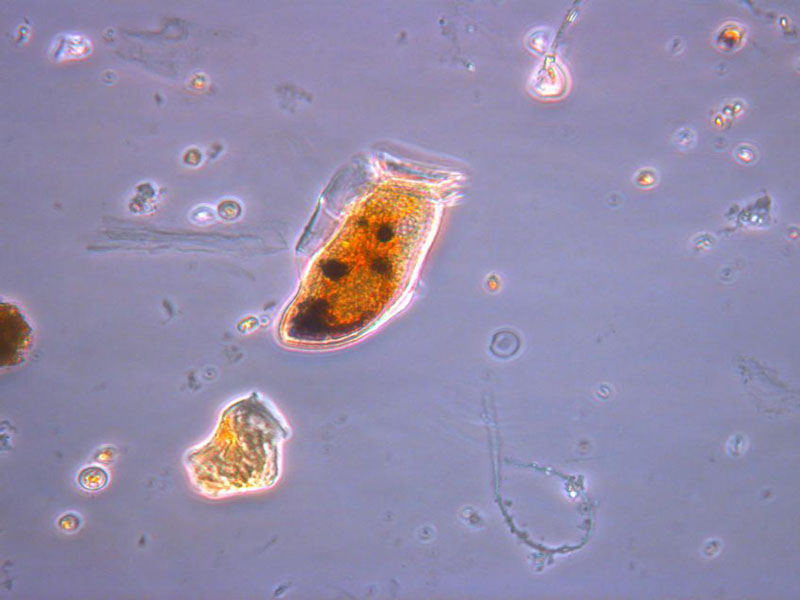
Gonyaulax polygramma
Algal Group: Dinoflagellates (Dinophyta)
Description
pear-shaped cells with horn on top portion; 40-60 µm long, 25-40 µm wide; girdle (cingulum) descends 1.5 x width
Where we found it
Indian River and Suwannee Sound
Sebastian
HB
Frequency of occurrence
Indian River: 20% in 116 samples taken
Suwannee Sound: 1% in 120 samples taken
What Are The Effects On Clams?
Good
Why is it good?
acceptable food item for clams
Ecological considerations:
Extreme bloom events can be associated with reduced oxygen levels in the water column.
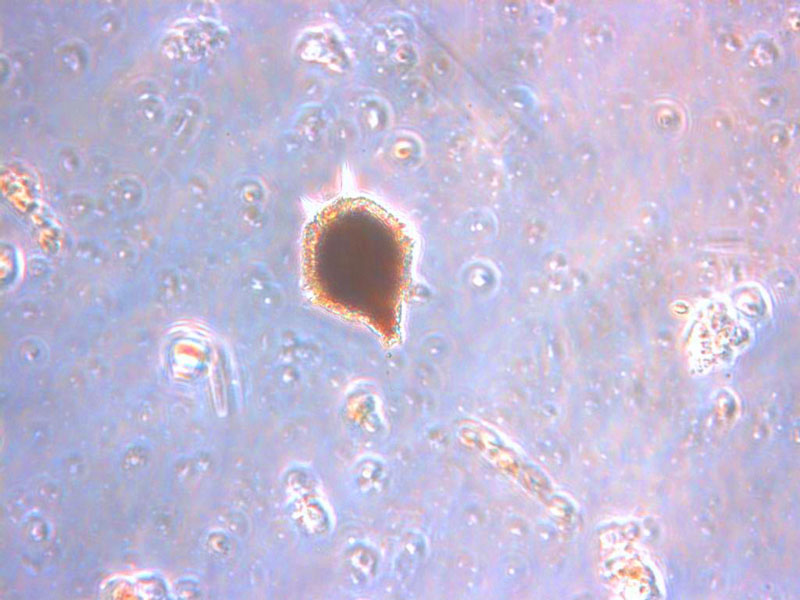
Gonyaulax spinifera
Algal Group: Dinoflagellates (Dinophyta)
Description
rounded cells; 21-32 µm diameter; girdle (cingulum) descends approximately 2 x width
Where we found it
Indian River and Suwannee Sound
Sebastian
DE;GJ;PI;HB;PR
Frequency of occurrence
Indian River: 5% in 116 samples taken
Suwannee Sound: 18% in 120 samples taken
What Are The Effects On Clams?
Good
Why is it good?
acceptable food item for clams
Ecological considerations:
Extreme bloom events can be associated with reduced oxygen levels in the water column.
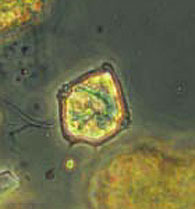
Gyrodinium estuariale
Algal Group: Dinoflagellates (Dinophyta)
Description
rounded cells; < 20 µm; displaced central girdle
Where we found it
Suwannee Sound
DE;GJ;PI;HB;PR
Frequency of occurrence
Indian River: 0% in 116 samples taken
Suwannee Sound: 48% in 120 samples taken
What Are The Effects On Clams?
Good
Why is it good?
acceptable food item for clams
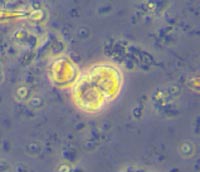
Gyrodinium spirale
Algal Group: Dinoflagellates (Dinophyta)
Description
spindle-shaped cells; 40-200 µm long; displaced central girdle
Where we found it
Indian River and Suwannee Sound
Sebastian
DE;GJ;PI;HB;PR
Frequency of occurrence
Indian River: 31% in 116 samples taken
Suwannee Sound: 43% in 120 samples taken
What Are The Effects On Clams?
Good
Why is it good?
acceptable food item for clams
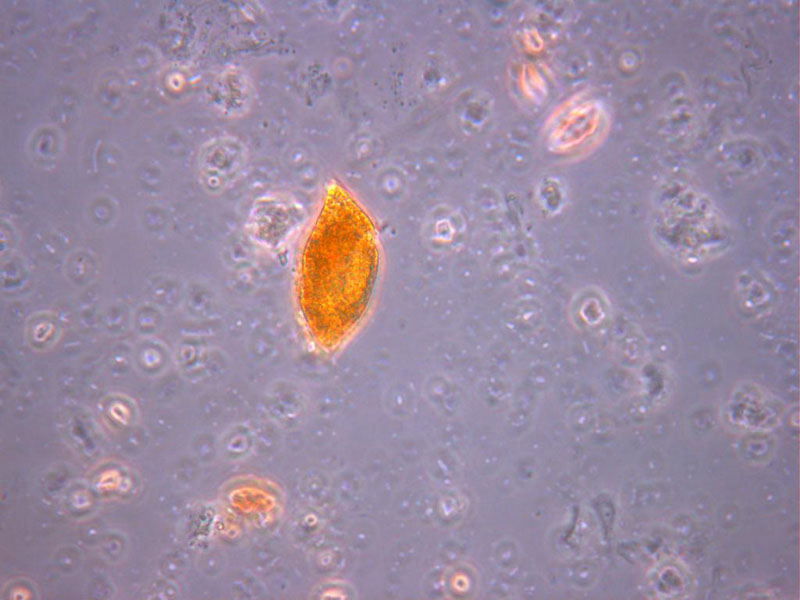
Karenia brevis
Algal Group: Dinoflagellates (Dinophyta)
Description
rounded cells with elevated central portion; 18−45 μm; central girdle; formerly known as Gymnodinium breve
Where we found it
Indian River and Suwannee Sound
Sebastian
DE;GJ;PI;HB;PR
Frequency of occurrence
Indian River: 2% in 116 samples taken
Suwannee Sound: 6% in 120 samples taken
What Are The Effects On Clams?
Good; Bad
Why is it good?
acceptable food item for clams
Why is it bad?
This species has been associated with production of brevetoxin, a neurotoxin responsible for neurotoxic shellfish poisoning (NSP).
Ecological considerations:
major bloom-former; blooms can occur any time of year, but most common in warm months; K. brevis blooms do not survive <24 ppt salinity; blooms start offshore on the midshelf and are associated with physical features such as currents and upwelling areas; K. brevis is capable of existing in low-nutrient waters because it is efficient in processing nutrients
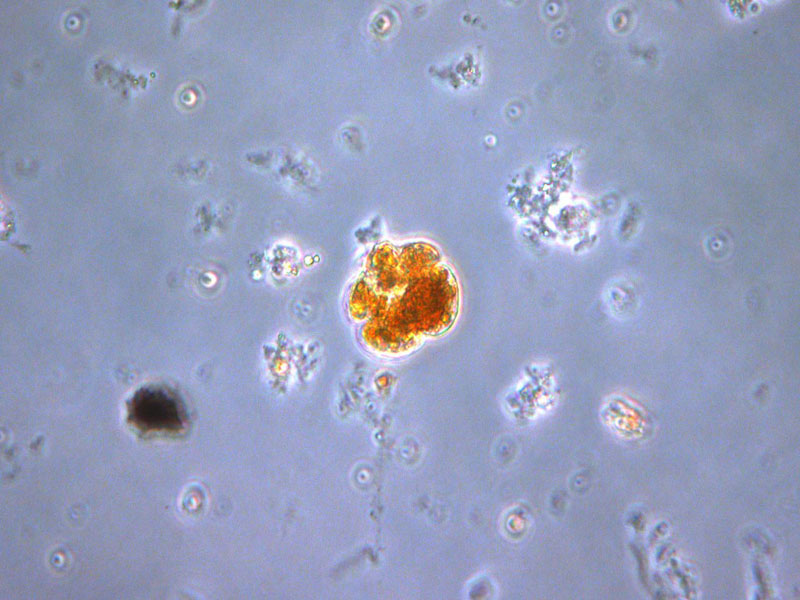
Katodinium rotundatum
Algal Group: Dinoflagellates (Dinophyta)
Description
arrowhead-shaped cell; < 20 µm
Where we found it
Indian River and Suwannee Sound
Sebastian
DE;GJ;PI;HB;PR;SR
Frequency of occurrence
Indian River: 6% in 116 samples taken
Suwannee Sound: 34% in 120 samples taken
What Are The Effects On Clams?
Good
Why is it good?
acceptable food item for clams
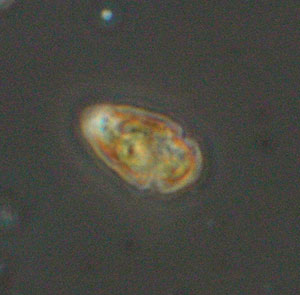
Pheopolykrikos hartmannii
Algal Group: Dinoflagellates (Dinophyta)
Description
barrel-shaped cells; > 50 µm long
Where we found it
Indian River
Sebastian
Frequency of occurrence
Indian River: 12% in 116 samples taken
Suwannee Sound: 0% in 120 samples taken
What Are The Effects On Clams?
Good
Why is it good?
acceptable food item for clams
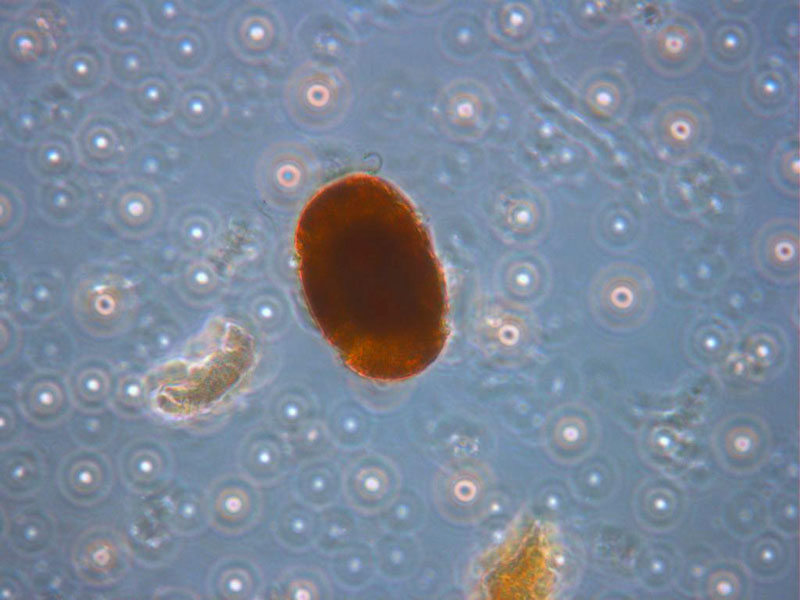
Prorocentrum micans
Algal Group: Dinoflagellates (Dinophyta)
Description
heart-shaped cells; 35-70 µm long, 20-50 µm wide
Where we found it
Indian River and Suwannee Sound
Sebastian
DE;GJ;PI;HB;PR;SR
Frequency of occurrence
Indian River: 58% in 116 samples taken
Suwannee Sound: 63% in 120 samples taken
What Are The Effects On Clams?
Good; Bad
Why is it good?
acceptable food item for clams
Why is it bad?
This species has been associated with production of okadaic acid, the toxin implicated in diarrhetic shellfish poisoning (DSP). Toxicity of local strains has not been confirmed.
Ecological considerations:
Extreme bloom events can be associated with reduced oxygen levels in the water column.
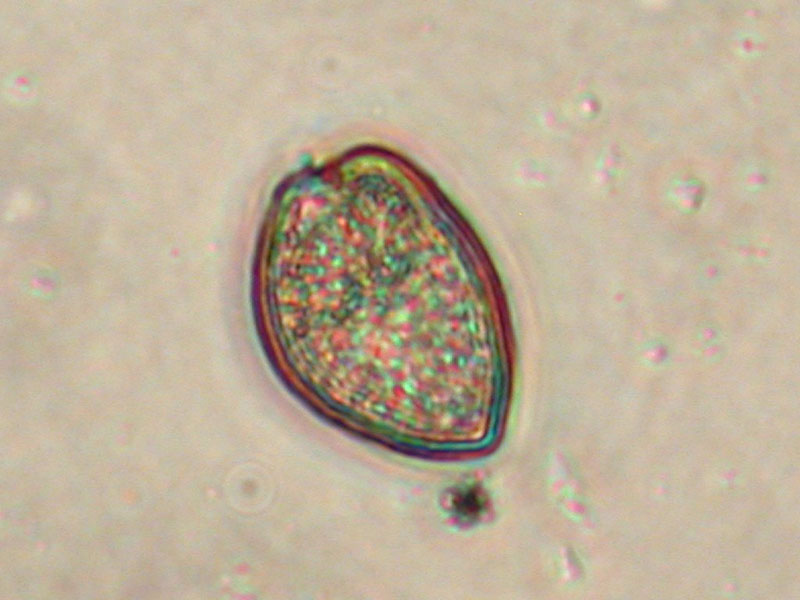
Prorocentrum minimum
Algal Group: Dinoflagellates (Dinophyta)
Description
triangular-shaped cells; < 20 µm
Where we found it
Indian River and Suwannee Sound
Sebastian
DE;GJ;PI;HB;PR
Frequency of occurrence
Indian River: 18% in 116 samples taken
Suwannee Sound: 33% in 120 samples taken
What Are The Effects On Clams?
Good; Bad
Why is it good?
acceptable food item for clams
Why is it bad?
This species has been associated with shellfish mortalities in other parts of the world (i.e., Chesapeake Bay), but the exact mode of toxicity is unclear.
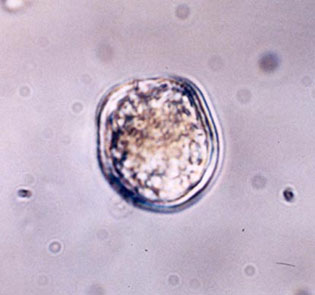
Pyrodinium bahamense var. bahamense
Algal Group: Dinoflagellates (Dinophyta)
Description
spherical cells; average 43 µm diameter; have a wing-like structure (list) that encircles the entire diameter, found individually or in pairs
Where we found it
Indian River
Sebastian
Frequency of occurrence
Indian River: 17% in 116 samples taken
Suwannee Sound: 0% in 120 samples taken
What Are The Effects On Clams?
Good; Bad
Why is it good?
acceptable food item for clams
Why is it bad?
This species has been associated with production of saxitoxin, a suite of toxins responsible for Paralytic Shellfish Poisoning (PSP). The toxin has been observed in the tissues of some fish species in Florida. However, unlike the Pacific form of Pyrodinium bahamense (i.e., var. compressum), which has been implicated in the deaths of numerous people via the consumption of tainted seafood, no human incidents of severe saxitoxin exposure have been documented in Florida.
Ecological considerations:
major bloom-former; blooms occur from April - November; a truly tropical species; the IRL is the northern-most region in North America where major blooms of P. bahamense var. bahamense have been observed
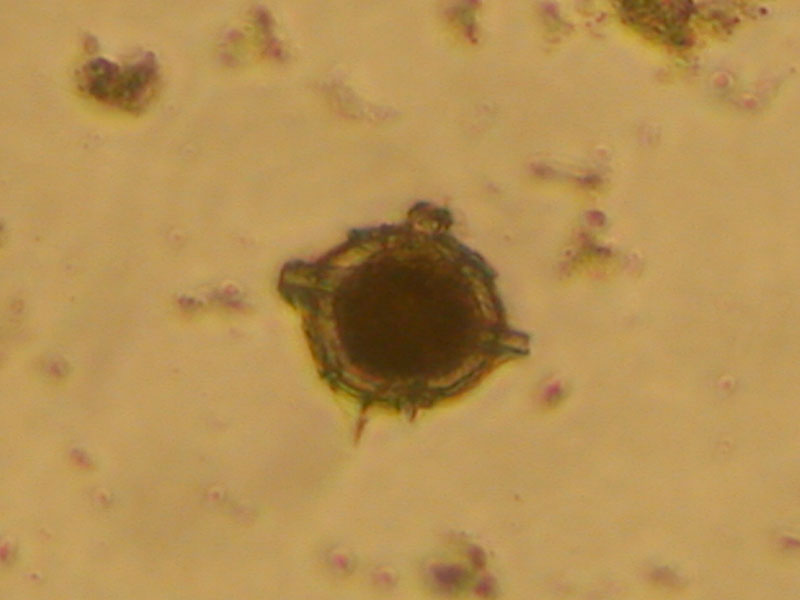
Scrippsiella spp.
Algal Group: Dinoflagellates (Dinophyta)
Description
rounded, pear-shaped cells; 16-36 µm long, 20-23 µm wide
Where we found it
Indian River and Suwannee Sound
Sebastian
DE;GJ;PI;HB;PR
Frequency of occurrence
Indian River: 8% in 116 samples taken
Suwannee Sound: 21% in 120 samples taken
What Are The Effects On Clams?
Good
Why is it good?
acceptable food item for clams
